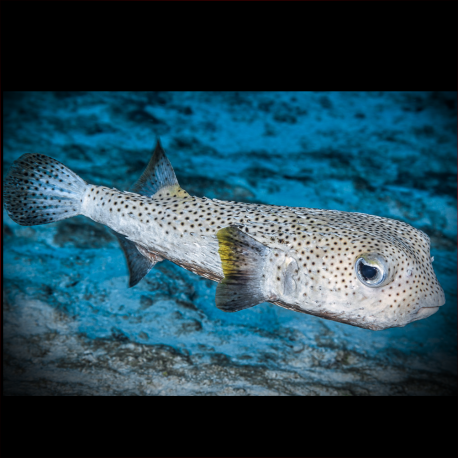More info
Datasheet
| Minimum Tank Size | 2000 litres / 528.34 US gallons |
| Maximum Size | 91.0cm / 35.83inches |
| Reef Compatible | Reef safe with caution |
| Temperament | Might be aggressive towards other species |
| Temperature | 22.2°C / 71.96°F - 25.6°C / 78.08°F |
| Specific Gravity | 1.020-1.025 |
| Carbonate Hardness | 8-12 |
| pH | 8.1-8.4 |
General Description
Spot-fin porcupinefish (Diodon hystrix) are members of the Diodontidae family, closely resembling pufferfish in appearance and behavior. These fish are known for their ability to puff themselves up when threatened, with a unique swimming style and characteristic spikes.
Aquarium Suitability
Considered suitable for aquariums, spot-fin porcupinefish require careful handling due to their potential toxicity. They may not be suitable for reef tanks as they can pose a threat to various invertebrates like shrimps, crabs, sea urchins, and snails.
Demands
Porcupinefish demand a substantial amount of food, preferably larger crustaceans, invertebrates, and small crustaceans to help grind down their continuously growing teeth. Handling and transport should be done with caution to prevent stress-induced toxin release.
Care and Hardiness
The hardiness of spot-fin porcupinefish is unknown, but under proper conditions, they can thrive for many years in captivity. These fish have a fun and interesting personality, but they may exhibit aggression towards other tank mates.
Reef Suitability
While reef-safe with caution, spot-fin porcupinefish may nibble on the fins of other fish in the aquarium and are not recommended for tanks with more aggressive species.
Aquarium Setup
A minimum tank size of 2000 liters is recommended for spot-fin porcupinefish. Care should be taken in the placement of electrical equipment, as these fish have been observed to blow water out of the tank, especially during feeding.
Behaviour
These fish are known for their playful and intriguing personality, adding a unique dynamic to the aquarium environment. One should avoid catching them with nets to prevent stress-induced puffing.
Feeding and Diet
Their diet should consist of foods that help prevent overgrowth of teeth, such as clams. Supplementing with a variety of seafood and frozen foods is essential to ensure their nutritional needs are met.
Dimorphism
There is no specific information available regarding dimorphism or captive reproduction of spot-fin porcupinefish.
Habitat and Distribution
Spot-fin porcupinefish can be found in various locations including the East Indian Ocean, West Indian Ocean, Australia, Japan, the Red Sea, and more. They are typically observed blowing water into the sand to expose their food, mimicking their natural feeding behavior in captivity.

